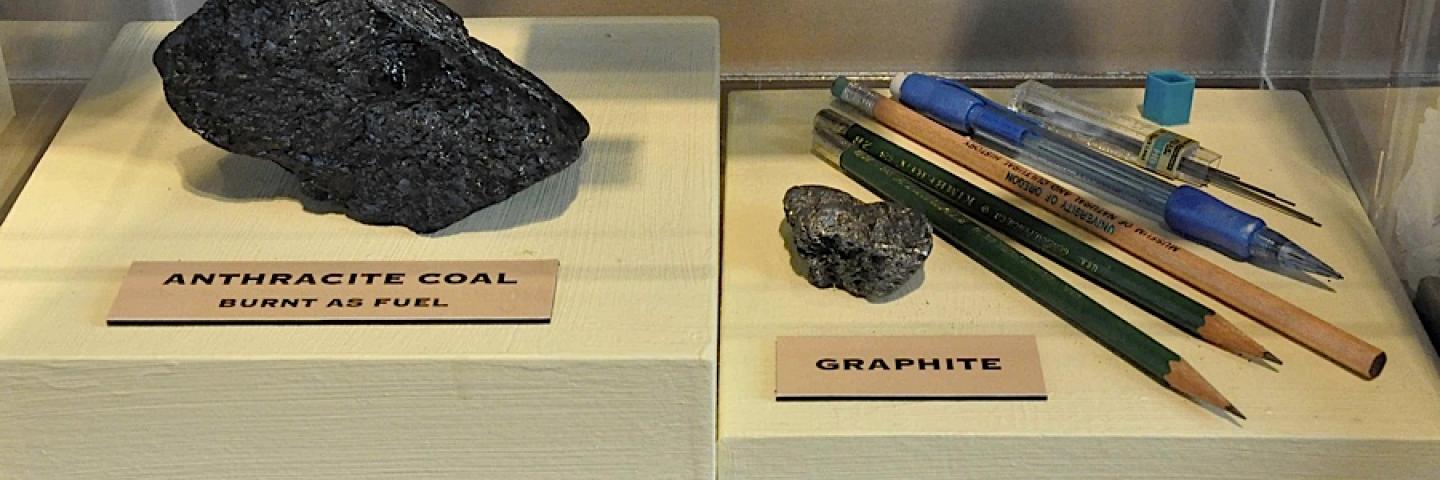 | Gypsum, chalk, and slate Gypsum is ubiquitous in our lives as the basis for drywall. It contains water in its mineral structure, which it loses when heated, providing an initial line of defense against building fires. In the time before dry-erase boards, all education relied upon chalkboards made from slate, which is clay that has been cooked by heat and pressure deep within the earth. Chalk is a limestone made of the skeletons of millions of microbes that once lived at the bottom of the sea , so it's really a fossil. |
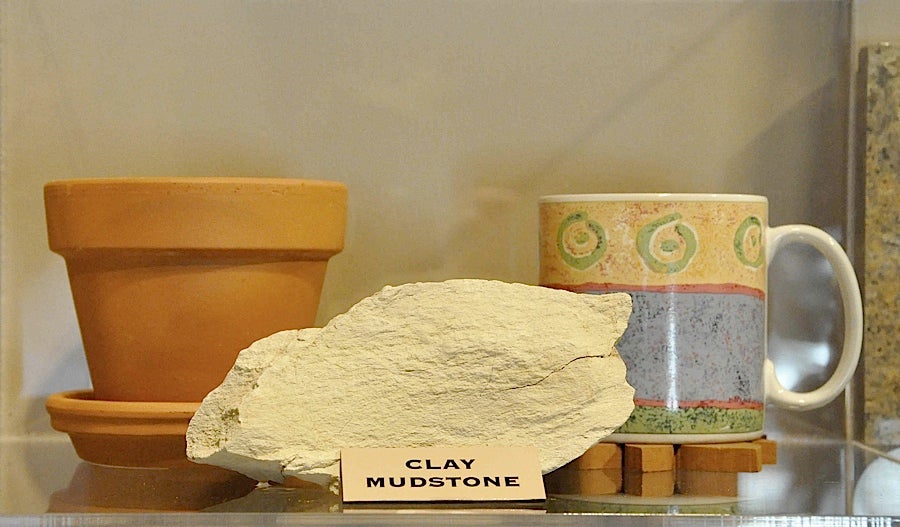 | Clay Mudstone Ceramics, from simple plant pots to extravagant porcelain, are made from clay mudstone. That's just a rock that forms from the compaction of mud. If it's buried deep enough, it becomes slate. |
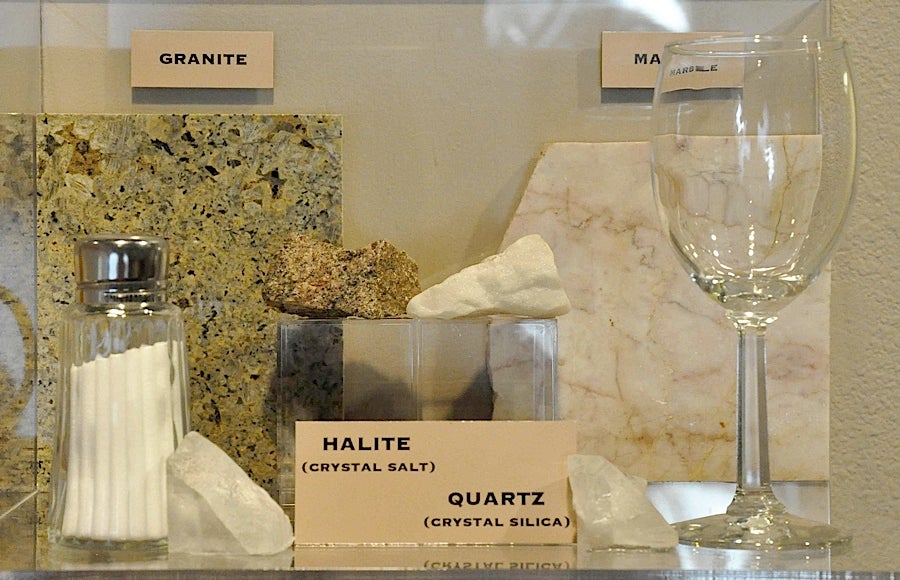 | Granite, Salt, Quartz, and Marble Granite and marble counter tops are made from stone. Granite forms when magma cools within the earth and never erupts from a volcano. The slower it cools, the larger the mineral grains that form. Marble is formed from limestone that is cooked by heat and pressure within the earth. Salt is a mineral formed from the elements sodium and chlorine, each of which is deadly on its own. Together they make an essential nutrient. Most salt is formed by the evaporation of sea water. Sea salt is made from the evaporation of seawater today, while regular salt is mined from ancient deposits created when seawater evaporated during warm intervals in the past. Glass is formed by melting quartz, the primary mineral found in sand. Sand is all that's left over after granite is ground down by streams, rivers, and the action of ocean waves. As the mineral quartz, silica is very hard, which is why it stays intact in sand, even as all of the other minerals from granite are destroyed. When it's melted into glass, it loses its mineral strength, but becomes clearer and can be formed while it's molten. |
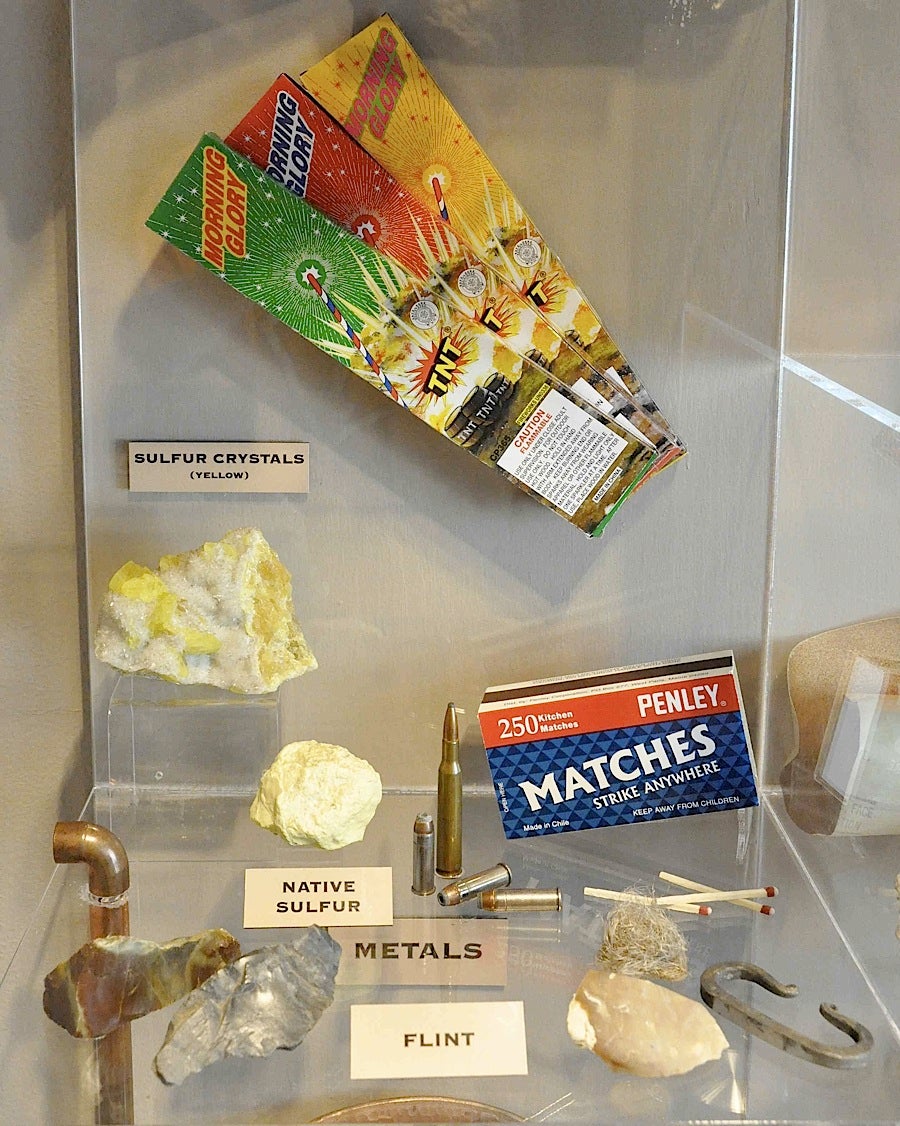 | Sulfur and Flint Sulfur is found as an element in nature, and is an integral part of gunpowder, which creates the explosive potential in fireworks and was once used in the propellant of bullets. Sulfur is also integral to matches, one of the most consistent ways to start a fire. Fires can also be started with flints and steel, illustrated here. Flint is a form of quartz that forms as nodules in limestones. |
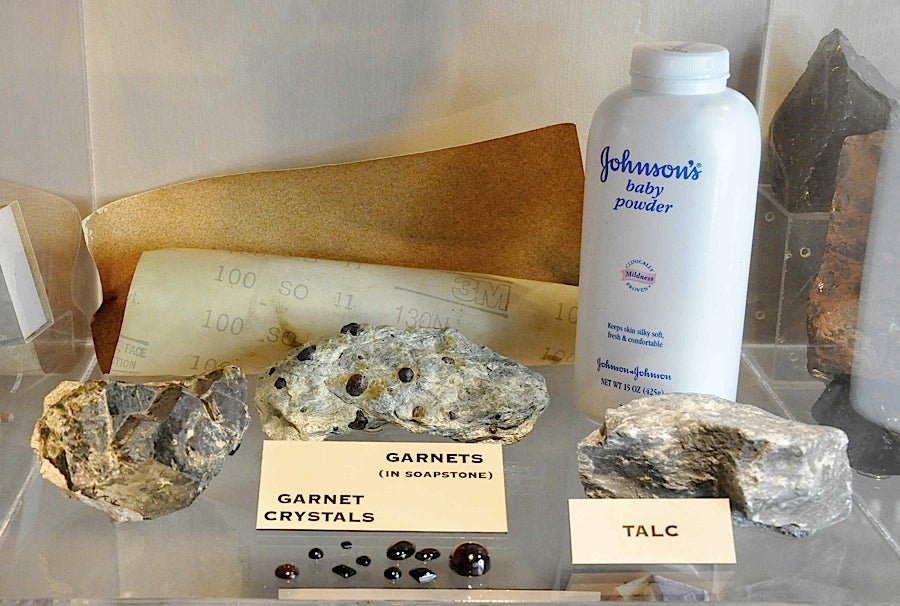 | Garnet and Talc Garnet is a gemstone composed of metals (calcium, magnesium, iron, aluminum, and/or chromium) bonded to silica. It has a relatively high hardness, harder than silica sand, so small grains are used as an abrasive for both sand blasting and in sand paper. In contrast, talc, used in baby powder, is a very soft mineral. It is composed of magnesium and silica, bonded with water, so it has some of the same elements as garnet, but the arrangement of its mineral structure makes it very weak -- hence its softness. Soapstone is composed primarily of talc. |
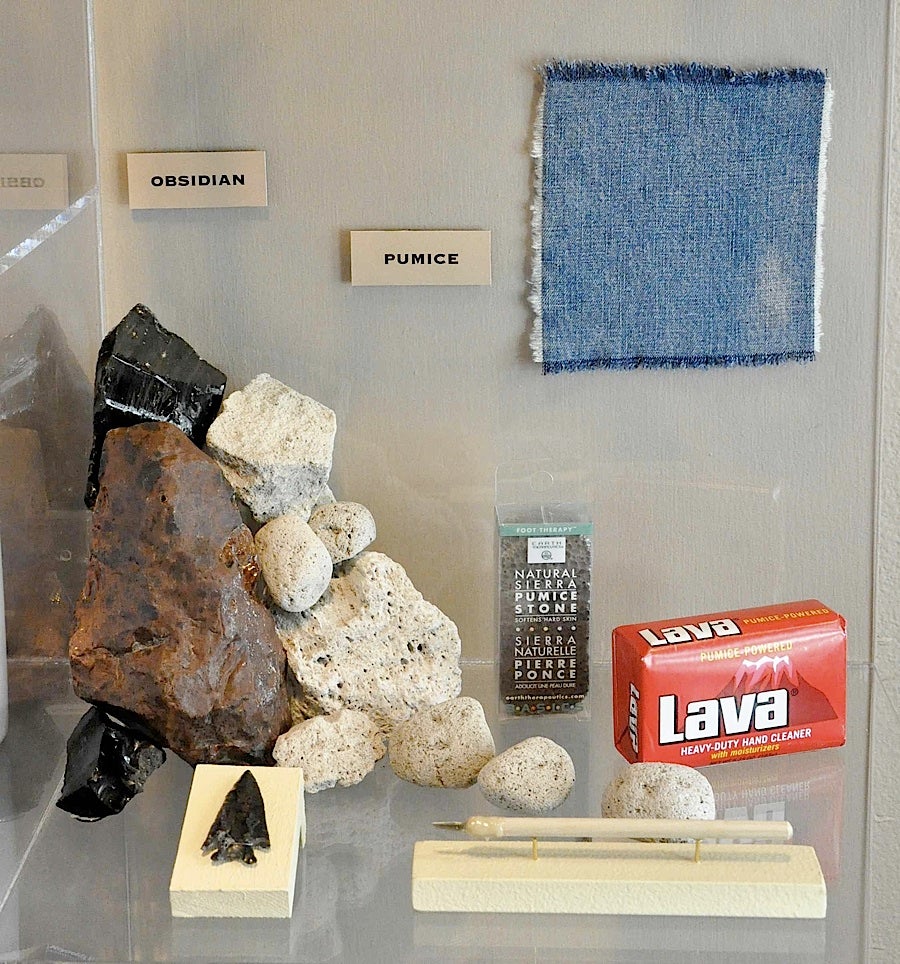 | Pumice and Obsidian The rocks on this shelf are produced by volcanic eruptions. Obsidian forms when lava cools very quickly, forming natural glass. It can be broken to produce extremely hard, sharp edges, which many cultures have used for projectiles and knives. Even today, some surgical scalpels are made from obsidian, as seen at the lower right of the image. Pumice is also formed by rapid cooling of lava. In this case, the lava is cooling as dissolved gasses are escaping, creating a large number of frozen bubbles in its structure. Imagine freezing a shaken-up cola as it foams out of the bottle. Pumice is used as an abrasive, illustrated here by pre-faded jeans, weathered by rubbing with pumice, and Lava brand soap, which includes pumice as a scouring agent for cleaning extra-dirty hands. |
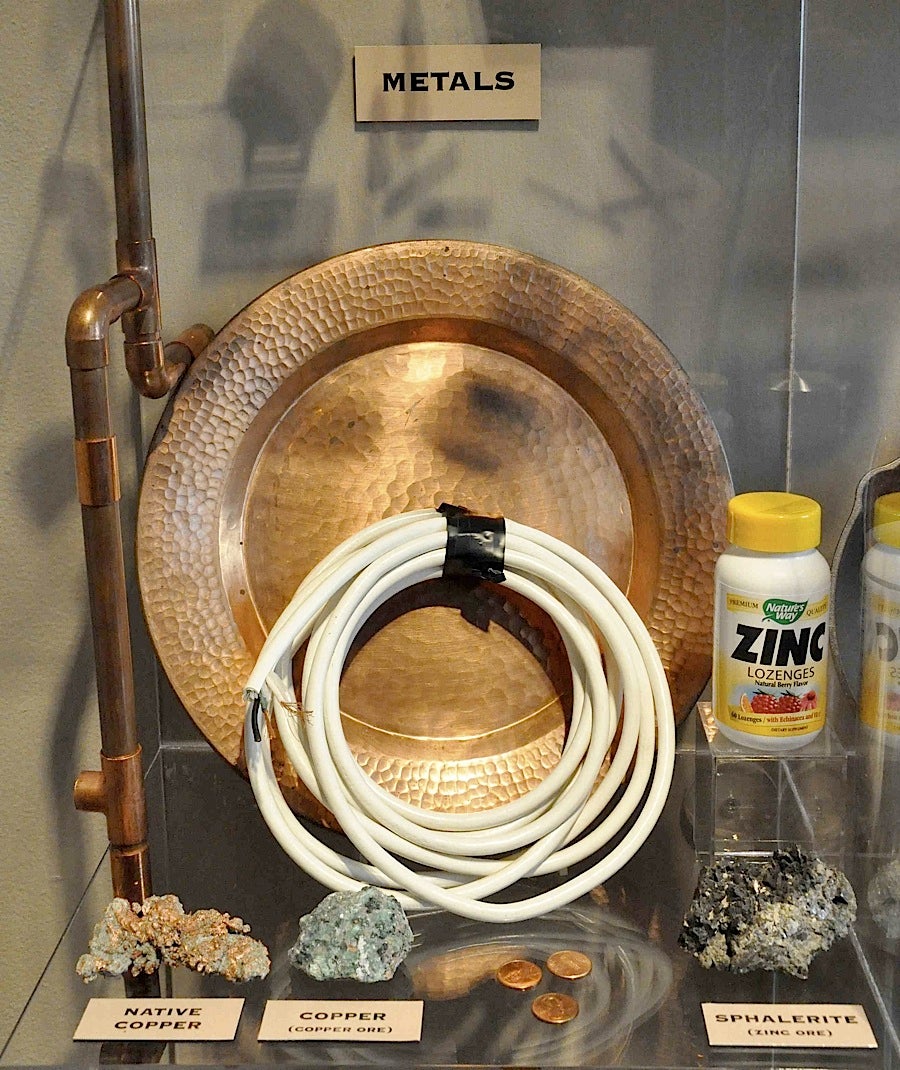 | Copper and Zinc Copper is used in the manufacture of electrical wire, copper pipes for water, copper cookware, and in the computer you're using to view this web gallery. Copper has low resistance to electrical charge and is relatively abundant, compared to its elemental sisters, gold and silver, which is why it's used for wiring. It can be found both in its elemental state and as an ore, in which the copper is bonded to other elements. Zinc has been reported as beneficial in shortening the duration of common colds, so it is often included in over the counter cold remedies. There have been no conclusive results supporting this use, but zinc is an essential element, so taking it as a supplement in reasonable doses cannot have any adverse effects. Zinc is often found naturally in sphalerite, a mineral including sulfur and iron. Zinc is also used for galvanizing, because it is relatively inert compared to steel, so it can prevent rusting when used as a coating. |
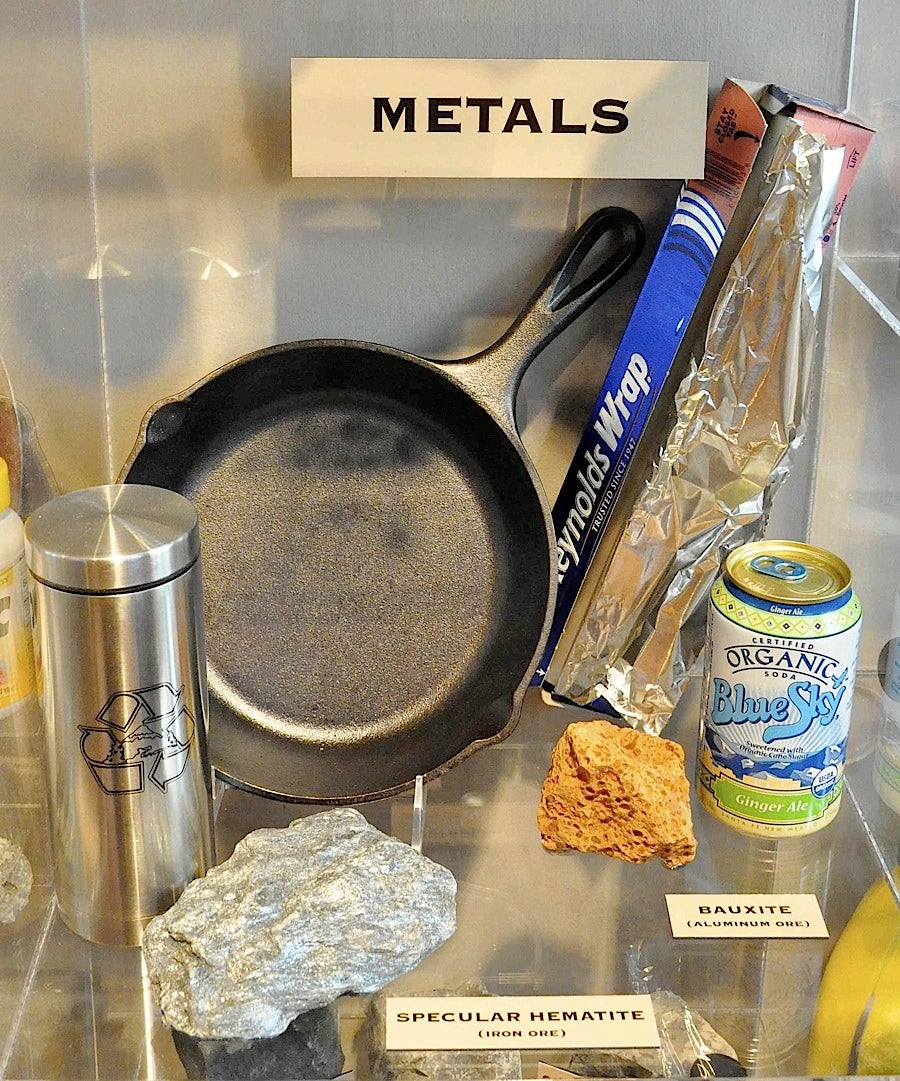 | Iron and Aluminum It's hard not to experience iron and aluminum in our everyday lives. Iron ores are usually compounds of iron and oxygen, otherwise known as rust. Much of these ores were formed when the earliest photosynthesizing microbes began to pump oxygen into the earth's oceans. In a way, iron ores are fossils, so all iron and steel we use are made from fossils. Iron is commonly used in different compound with carbon and silicon. Different ratios of the other elements determine its physical properties, which vary between cast iron, as in the frying pan, and steel, as in the reusable coffee cup. Aluminum is found naturally as bauxite, made of aluminum bonded with water. Purifying bauxite used to be expensive and slow, so aluminum was a rare and valuable metal in the 18th and 19th centuries. That's why the top of the Washington monument was covered in aluminum -- it was like covering it in silver! Since the late 1880s, aluminum ore has been purified using electricity, and it has become cheap and plentiful. Benjamin Franklin would think we all live like kings if he knew that we casually drink out of aluminum cans and use aluminum foil to save our leftovers. |
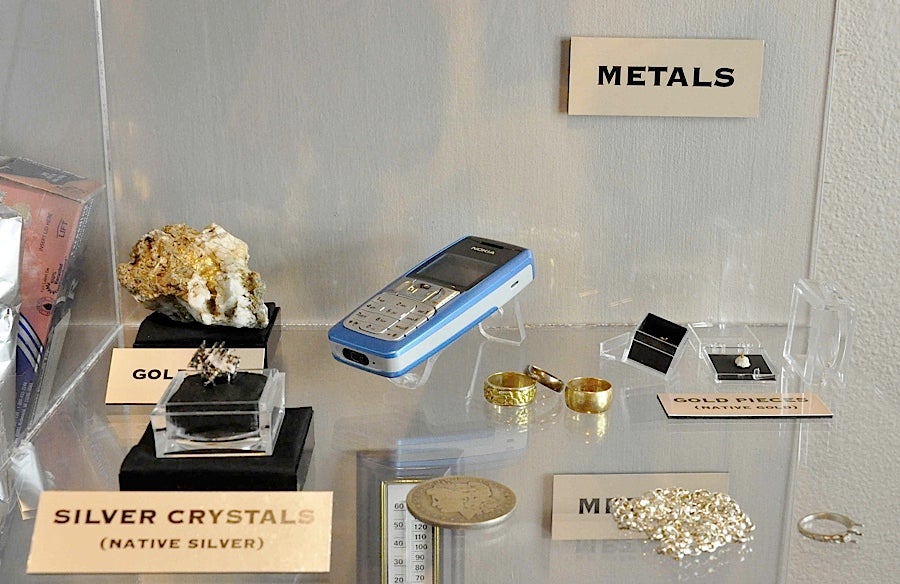 | Silver and Gold This shelf features silver and gold, sister elements to copper. On the periodic table they're all in the same column, and that reflects the similar structures of their atoms, which give them similar chemical properties. They're all good conductors of both heat and electricity. Gold and silver are actually better conductors than copper, which is why they're used in high-end electronic devices, like cell phones and some audio equipment. They're rarer than copper, too, which is why gold and silver jewelry is more valuable and why they're used more often for decoration than for their electrical properties. Gold is most often found as a pure element in nature, but silver is often found both in its pure form and in ores. |
 | Mercury and Lead This shelf features mercury and lead, two important dense metals. Mercury is the only metal that is liquid at room temperature, which is why it has been used for so long in thermometers. As the metal expands and contracts in response to the temperature, it moves up and down the thin tube, and allowing the temperature to be read. Elemental mercury is poisonous, producing mental and coordination problems, so people have moved away from mercury thermometers and other everyday uses. Mercury is not found as a pure element in nature. It is mined from mercury ores, such as cinnabar (also called vermilion). Cinnabar is composed of mercury and sulfur and has been used as a red pigment since ancient times. Lead is a very dense, very soft metal and has a low melting point, which allows it to be easily formed. Its density and easy of forming have made it the most common metal for bullets since the origin of firearms. It has also been used for fishing weights, as illustrated here. Its density is so great that it is used as a radiation shield. We most often see it in dentists' offices in the lead apron we wear to protect us from X-rays, but it is also used to shield nuclear reactors because it can capture any stray radiation before it enters the environment. Lead is, like mercury, poisonous, so it is beginning to fall out of everyday use. Its most common use today is in the lead-acid batteries found in automobiles. Lead is found in nature most often as galena, a compound with sulfur. |
 | Limestone, Sand, and Gravel The concrete that makes up most of the urban landscape is actually an artificial reconstruction of a naturally occurring rock, conglomerate. To make concrete, we mix sand and gravel, with cement. Cement is created by heating ground limestone with other minerals. When hot enough, the limestone releases carbon dioxide and becomes quicklime, the primary ingredient in cement. When the quicklime in cement reacts with water, it forms a stable crystal: this is what happens when concrete 'dries'. The process of making cement from limestone releases carbon dioxide, consequently, the cement industry is second only to power production in the release of carbon dioxide gas into the atmosphere. |
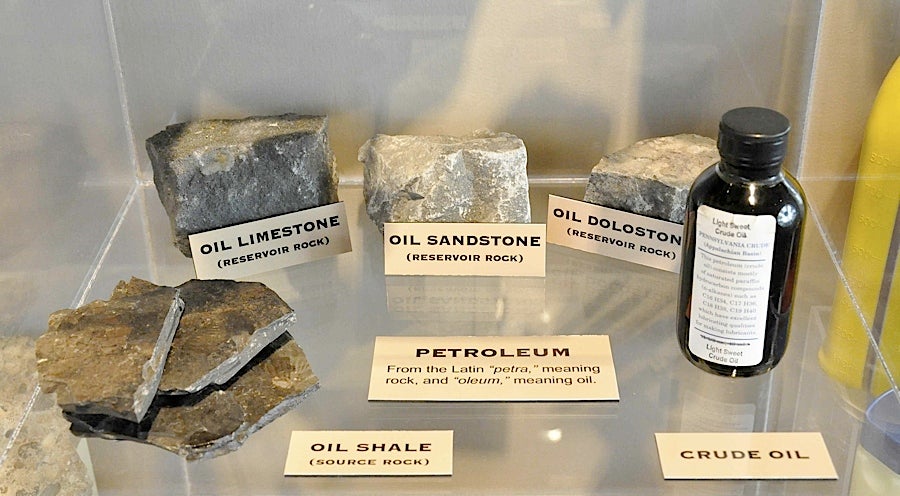 | Oil When we describe oil and coal as fossil fuels, we mean it: they are produced by the cooking of decomposed plant and animal matter deep in the earth's crust over many millions of years. Fossil fuels are a form of solar power: they are energy from the sun trapped by plants millions of years ago. Oil is formed in oil shales, but once it becomes liquid it tends to rise until it is trapped in a porous reservoir rock, like the ones shown here. Drilling into the reservoirs releases the oil for human use. Finding oil is a tricky proposition, combining the science of geology with the art of imagining where the oil would flow within the crust. |
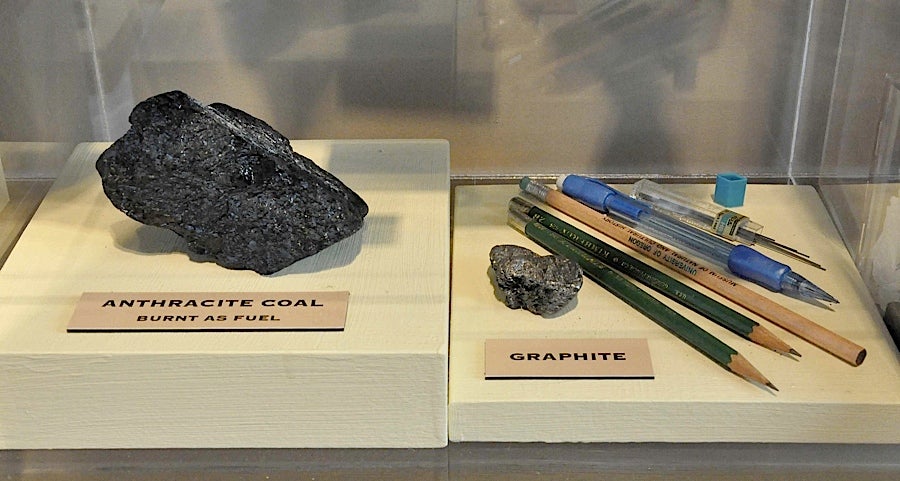 | Coal and Graphite Coal is simply the remains of woody plants that died in swampy conditions and was cooked down into a solid mass. Large amounts of wood accumulated on earth during the Carboniferous period, 359 to 299 million years ago, because plants evolved wood and no organisms on earth evolved the ability to digest wood for 50 to 60 million years! Think of a world where tree trunks never decompose because there are no microbes that know how to break them down. That's the Carboniferous world that left us with a legacy of coal. Graphite is elemental carbon, just like diamond. The difference is that diamond forms at extremely high pressures, which cause the carbon atoms to line up in a strong mineral. Graphite is formed under much lower pressures and has a mineral structure that makes it slippery and easy to break. We use it for the 'lead' in pencils because it makes a good, but erasable, mark. We also use it as a powder for lubrication. Both coal and graphite are composed primarily of carbon. |
 | Petroleum Products Here we see some of the many products made from petroleum, or crude oil. Oil is used as a machine lubricant, as with the 10W-40 oil. All of the rubber and plastics here are made from oil, including the gas can. The gas can also represents gasoline, the ubiquitous fuel that is refined from crude oil. Diesel fuel is also refined from crude oil. Some scientists have suggested that future generations will be amazed that we burned so much of our oil as fuel, instead of using it for more permanent applications like plastics. Try to think of a day in your life without plastic. |
